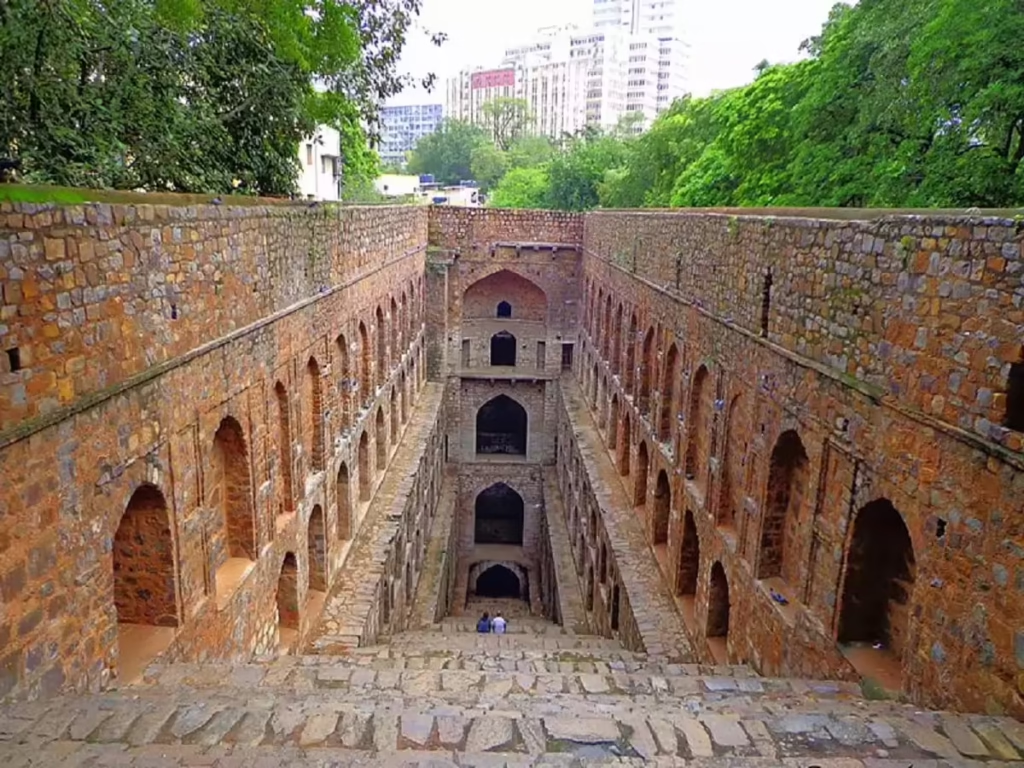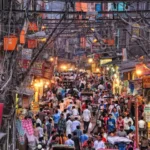Tucked away in the bustling heart of Connaught Place lies a monument that many walk past unknowingly, oblivious to its echoes of a distant past. Welcome to Agrasen ki Baoli—an ancient stepwell that doesn’t just whisper tales from history but roars with mystery, architecture, and urban legend.
Whether you’re a history enthusiast, architecture lover, or just someone seeking silence in the chaos of Delhi, Agrasen ki Baoli offers an experience like no other. But what makes this seemingly quiet place so captivating?
🧱 What Is Agrasen ki Baoli?
Agrasen ki Baoli is a 60-meter-long and 15-meter-wide stepwell located on Hailey Road, just a short walk from Barakhamba Road in central Delhi. Though no official records confirm its origin, it is believed to have been rebuilt during the 14th century by the Agrawal community, tracing its roots to King Agrasen, a legendary ruler from the Mahabharata era.
Architectural Highlights:
- 108 steps, descending into a dark pit that once held water
- Built using limestone rubble masonry
- Combination of Tughlaq and Lodi era styles
- Consists of three levels, each with arched niches—once used for rest and meditation
Despite being dry today, it remains one of the few surviving baolis (stepwells) in Delhi and offers a rare look into pre-Mughal water architecture.
🕰️ A Portal to Delhi’s Forgotten Past
Stepwells in India weren’t just water reservoirs; they were community spaces—used for rituals, rest, and even shelter during scorching summers.
Agrasen ki Baoli is no different. With its symmetrical steps, echoing chambers, and deep shadows, it served not only as a water conservation marvel but also a cultural and spiritual gathering point.
But what sets this baoli apart isn’t just its structure—it’s the atmosphere. The moment you descend the first few steps, the noise of modern Delhi fades away. There’s an almost cinematic silence—a space where time seems to pause.
👻 Haunted or Hyped? Unraveling the Urban Legends
Agrasen ki Baoli is often dubbed one of the most haunted places in Delhi. But is it just myth or something more?
The Common Stories:
- Locals speak of a “black water” myth, suggesting that the baoli was once filled with dark, hypnotic water that lured people to commit suicide.
- Visitors often report an uneasy feeling—as if being watched—especially in the lower levels.
- Some paranormal investigators have claimed energy shifts, temperature drops, and sound anomalies during night visits.
While there is no documented evidence of hauntings, the stories have fueled its reputation as a paranormal hotspot, making it a favorite among thrill-seekers and ghost enthusiasts.
“Haunted or not, the silence here is loud. It echoes with forgotten footsteps, whispered stories, and maybe… something more.”
— Local heritage guide
🧭 Agrasen ki Baoli vs. Other Delhi Monuments
Here’s how Agrasen ki Baoli stands out among Delhi’s architectural gems:
| Feature | Agrasen ki Baoli | Qutub Minar | Humayun’s Tomb |
|---|---|---|---|
| Type | Stepwell | Minaret | Mughal Tomb |
| Built By | Rebuilt by Agrawal community | Qutub-ud-din Aibak | Emperor Humayun’s family |
| Time Period | Possibly 14th Century | 12th Century | 16th Century |
| Accessibility | Free Entry | Paid Entry (INR 35/550) | Paid Entry (INR 35/550) |
| Footfall | Medium (Hidden Gem) | High (Tourist Attraction) | Medium-High (Tourist Site) |
| Unique Appeal | Haunted reputation + silence | Tallest minaret | Mughal garden architecture |
📍 How to Reach Agrasen ki Baoli
- Nearest Metro: Barakhamba Road or Rajiv Chowk (5–10 minutes walk)
- Location: Hailey Road, KG Marg area, near Connaught Place, New Delhi
- Timing: 9 AM – 5:30 PM (Monday–Sunday)
- Entry Fee: Free
💡 Tip: Early mornings or late afternoons are best for photography and peaceful exploration.
📸 The Baoli Through a Storyteller’s Eyes (Personal Experience)
I first visited Agrasen ki Baoli on a sweltering June afternoon, expecting just another monument. But what I found was something much deeper—both literally and emotionally.
As I descended the symmetrical steps, each level felt like stepping back in time. I noticed a group of students sketching the arches, a Sufi musician strumming his ektara, and a solo traveler whispering verses into her phone mic. This wasn’t just a tourist spot—it was a living canvas of urban India.
Sitting in one of the shadowed alcoves, I felt a strange calm. The kind that only places with centuries of forgotten memories can offer.
🌐 Agrasen ki Baoli in Pop Culture
Agrasen ki Baoli has found its way into modern media too:
- 🎬 PK (2014): Aamir Khan’s alien character is seen sitting at the baoli, adding surrealism to the location.
- 📷 Instagrammers and photographers often use it for portraits, fashion shoots, and architecture reels.
- 🎭 Cultural festivals and heritage walks frequently highlight it in Delhi’s storytelling circuits.
It has quietly become a symbol of contrast—between Delhi’s chaotic surface and its meditative underbelly.
🔗 Helpful Links and Resources
- Learn more about Stepwells in India
- Join a Heritage Walk around Connaught Place
- Read about Haunted Places in Delhi
💡 Key Takeaways
| Insight | Details |
|---|---|
| Location | Hailey Road, near Connaught Place |
| Historical Significance | Rebuilt by Agrawal community, possibly 14th century |
| Architecture | Stepwell with 108 steps, 3 levels, and symmetrical arches |
| Mystery | Haunted stories and energy shifts reported |
| Experience | Free to visit, great for solitude, photography, and storytelling |
🙌 Conclusion: Why Agrasen ki Baoli Still Matters
In a city where malls rise faster than memories, Agrasen ki Baoli offers a moment of pause. It reminds us of the ingenuity of ancient India, the layered history beneath our feet, and the stories still waiting to be told.
Whether you believe in ghosts or not, whether you’re a photographer, a history nerd, or a curious wanderer—this baoli is worth your time. Not for the myths alone, but for the magic it quietly holds.
🚪 Ready to Explore?
If you’ve ever walked the streets of Delhi and thought, “There must be more to this city,”—then Agrasen ki Baoli is your answer.
🧭 Share your experience if you’ve been there—or better yet, go visit and tell us what you felt.
📸 Tag your photos with #DilliAtlas and let the stories unfold.



